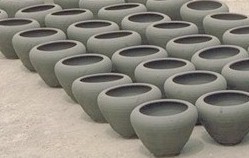 |
| D.4. | Drying: | |||
After the clay has been shaped into vessels and the appropriate decoration has been added, the pots are dried in the sun until they are leather-hard. This is often a dangerous stage as it can reveal stresses or cracks in the vessel: films of water that surround each clay particle evaporate and draw closer together, causing the clay body to shrink and lose its plasticity. Evaporation occurs through capillary action: the surface of the vessel dries faster, so water moves from pores in the interior towards the exterior and is evaporated from the surface. In clays with a coarser, more open structure, drying is rapid and shrinkage is low; however in fine clays with a more extensive network of capillaries, drying is slower and there is a greater risk of the pot warping. Therefore another reason why potters add coarser inclusions to their clay is to promote water movement from the interior to exterior of the pot.
As Abu’l-Qasim describes, when the pot is leather-hard it is returned to the wheel and pared down to remove excess clay, and feet and handles may be added. The pot may be washed down with a damp linen cloth in order to obliterate the markings made in the clay by the throwing process. When dry again, they are rubbed with a wool cloth until they are clean and smooth.